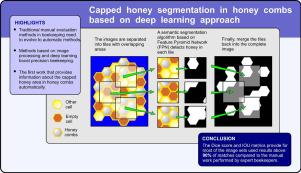基于深度学习方法的蜂巢封盖蜜细分
IF 8.9
1区 农林科学
Q1 AGRICULTURE, MULTIDISCIPLINARY
引用次数: 0
摘要
蜂蜜是蜜蜂在田间缺乏食物时储存的食物,也是全世界人类消费的产品。根据蜂群数量、健康状况或环境因素的不同,每个蜂巢产生的蜂蜜量也不同。事实上,蜂蜜储量为养蜂人提供了双重功能:预测可获得的蜂蜜量和分析蜂群状况。在与蜂群健康、遗传改良或环境问题相关的科学研究中,对蜂蜜储量进行评估已是司空见惯的事,而新兴技术则可为评估蜂巢中储存的蜂蜜提供有用的工具。在此背景下,这项工作提出了一种方法,利用基于深度学习的方法自动检测高分辨率照片中的蜂蜜区域。具体来说,该方法采用了一种 "分而治之 "的方法,即把图像分割成具有重叠区域的瓦片,由基于特征金字塔网络(FPN)的语义分割算法使用,检测每个瓦片中的蜂蜜,最后将瓦片合并成完整的图像。该建议与不同的特征提取器(骨干)和其他语义分割模型进行了比较,在 Dice score 和 IOU 指标上分别获得了平均高于 90% 和 87% 的准确结果。本文章由计算机程序翻译,如有差异,请以英文原文为准。

Capped honey segmentation in honey combs based on deep learning approach
Honey is the food stored by honey bees for periods when it is scarce in the field as well as being a product that is consumed worldwide by humans. Each hive generates different amounts of honey depending on the population of the bee hive, health state or environmental factors. In fact, the reserves of honey provide beekeepers with a double function: to predict the amount of honey that can be obtained and to analyze the state of the bee colonies. The assessment of honey reserves is commonplace in scientific research related to the health of bee colonies, genetic improvement or environmental issues, and emerging technologies can provide useful tools to evaluate honey stored in hives. In this context, this work proposes a methodology to detect the honey areas in high resolution photographs automatically using methods based on deep learning. Specifically, the methodology follows a “divide and conquer” approach where the images are separated into tiles with overlapping areas that are used by a semantic segmentation algorithm based on Feature Pyramid Network (FPN), detecting the honey in each tile to finally merge the tiles back into the complete image. The proposal has been compared with different feature extractors (backbones) and other semantic segmentation models, obtaining on average accurate results above 90% and 87% in the Dice score and IOU metrics respectively.
求助全文
通过发布文献求助,成功后即可免费获取论文全文。
去求助
来源期刊

Computers and Electronics in Agriculture
工程技术-计算机:跨学科应用
CiteScore
15.30
自引率
14.50%
发文量
800
审稿时长
62 days
期刊介绍:
Computers and Electronics in Agriculture provides international coverage of advancements in computer hardware, software, electronic instrumentation, and control systems applied to agricultural challenges. Encompassing agronomy, horticulture, forestry, aquaculture, and animal farming, the journal publishes original papers, reviews, and applications notes. It explores the use of computers and electronics in plant or animal agricultural production, covering topics like agricultural soils, water, pests, controlled environments, and waste. The scope extends to on-farm post-harvest operations and relevant technologies, including artificial intelligence, sensors, machine vision, robotics, networking, and simulation modeling. Its companion journal, Smart Agricultural Technology, continues the focus on smart applications in production agriculture.
 求助内容:
求助内容: 应助结果提醒方式:
应助结果提醒方式:


